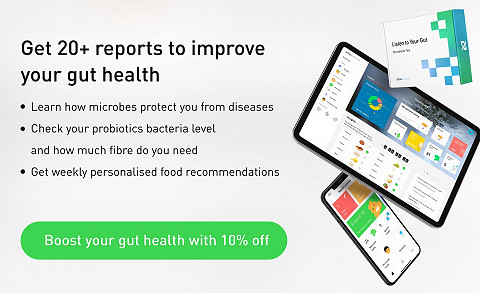-
Atlas Microbiome Test
review on 1 September 2018
by Ellen Hinkley

The Atlas Biomed test looks at your DNA as well as the microbiome (bacteria in your gut). The test covers a lot of different areas and the level of scientific backing for the reports was somewhat unclear from the website.
Accurate communication
The Atlas Biomed DNA and microbiome test offers a broad array of information from Ancestry through to dietary recommendations. The lack of information about the science underlying the actionability of diet recommendations and which health conditions they report on made it difficult to verify their accuracy. The site references >20,000 research reports in this area, and it would be helpful to see which ones they use to inform their reports.
Scientific backing
Atlas Biomed describes three categories of microbiome – the Urban Citizen, the Village Peasant and the Indigene. I was not able to find any scientific evidence for how these three categories are defined, or how they relate to disease risk/management, and I would have liked to have seen more information on this. Establishing cause and effect with the microbiome is very challenging, so I would like to see underlying research before trusting disease risk predictions based on the microbiome.
Ethics and consent
The terms and conditions clearly state ‘that you will be asked for further consent to use your anonymised results/data in further research activities after we have presented your results to you.’

At a Glance
Summary
The ‘Microbiome Test’ from Atlas Biomed provided loads of information about my gut bacteria. I particularly enjoyed the unusual features, such as finding out the nationality of my microbiome, and thought that the food recommendations provided a helpful way to act on the information.
There was a lot of quite complex extra information provided and the same results were often featured in several different sections of the report, which made it a bit confusing to navigate. However, the wealth of information there was to explore, and its varying complexity, meant that the test could provide insights for a wide range of customers, with differing levels of knowledge and experience of the microbiome. I would, therefore, recommend this test to anyone who is keen on exploring their own gut bacteria in detail.
Full Review
Atlas Biomed are the company behind the world’s first DNA and microbiome health platform. From their headquarters in London, UK, they sell these two types of test with the aim of enabling customers to take control of their health, and promote preventative rather than reactive responses to disease. The company was founded earlier this year and has already received considerable media attention for its novel approach to maintaining and improving health, with City AM and The Express among the publications that have featured the tests.
After reading about Atlas Biomed’s innovative approach and impressive ambitions, we had to give their Microbiome Test a go!
Product Expectations
Visiting the Atlas Biomed website, I was immediately faced with the bold statement ‘You can change’ and was prompted to ‘Scroll Down’ to see the tests. Images of the two kits, ‘DNA’ and ‘Microbiome’ were displayed next to each other, with bullet points beneath each that explained their features.
Looking through these bullet points, I read that the Microbiome test would provide me with information about how my microbiome might affect my health, how my diet could influence my microbiome and would also make nutrition recommendations.
This sounded interesting, but at this point I wasn’t quite sure what a microbiome actually was. Luckily, there was a helpful page on the website dedicated specifically to the Microbiome test that provided plenty of information about it. It described the microbiome as “a community of bacteria living in your colon” and went on to explain that it contributes to digestion and immunity. This page made something that had seemed complex easily understandable.
Beneath this explanation, there was a list of questions. Looking through them, it became apparent that these were questions the test report would be able to answer. I thought this was an effective way to describe the test’s features in more detail and loved the little cartoon character (I assumed it was a microbe) that provided the answers in speech bubbles.
There was an abundance of other information provided about the test, including the exact technique that would be used to analyse the bacterial DNA in my microbiome (16rRNA sequencing) and details of the sections that would be covered in the results. There was also a page dedicated to the testing process, which broke it down into seven steps, using more of the funny cartoon microbes, and included images of the different kit components Overall, I was really impressed by the amount of information Atlas Biomed had provided about the test and process, without making it seem overwhelming or daunting.
Ordering Experience
When I clicked to buy the test, I was taken straight to the order page, where I entered my name, address, email and phone number. I was pleased to see that delivery of the kit was estimated to take only 2-3 days, but was less pleased when I scrolled down to see that I had to pay an extra £9.99 for shipping.
Before proceeding to payment, I had to agree to Atlas Biomed’s terms and conditions. I’d been impressed by the privacy information I’d seen on the ‘How it works’ page, which had included the exact type of encryption and security that the company used. Looking through the terms and conditions, this protection was confirmed, though I was slightly concerned to read that Atlas Biomed could use my genetic and self-reported data for research and development of products or services that I would be able to claim no compensation for. I was also a little alarmed by the advice that I consult with a legal professional before sharing my genetic results with anyone, as they could be used against my interests. However, despite my initial alarm, I appreciated being made aware of this.
After reading through and accepting these terms and conditions I was able to enter my card details and paid via Stripe. A warning at the very bottom of the page stated that I shouldn’t take a sample within three months of taking a course of antibiotics. I was surprised that I hadn’t seen this mentioned anywhere earlier, and it was small enough that I could have easily have missed it, even at this point.
The kit arrived within the estimated time and looked exactly like the one on the website. Registration was simple and although taking a stool sample had sounded a bit messy, the process wasn’t quite as bad as I had expected (though it still wasn’t particularly fun!). Return postage had been included, making it easy to send back to the lab.
The Results
I didn’t hear anything for around a month, so was a bit worried that my sample had got lost in the post. However, I then received an email informing me that my results would be slightly delayed due to technical problems at the lab. Although I was disappointed that I’d have to wait a little longer for my results, I appreciated that I’d been informed about why.
I finally received my results about six weeks after dispatching my sample, which, taking into consideration the time it took to reach the lab, was still just about within the five weeks that had been estimated on the website.
The results were available via the account I’d set up when registering my kit. After logging in, I was greeted by a homepage, which was titled ‘Your health profile’ (shown below).
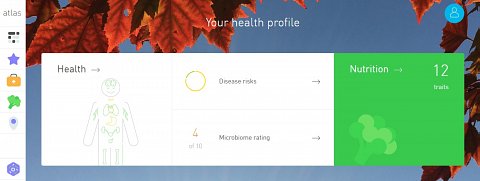
My Health Profile homepage.
Hovering over the icons on the left opened a menu of the sections included in the report: ‘Recommendations’, ‘Health’, ‘Nutrition’ and ‘Ancestry’.
Results Section: Health
As the Health option was the first on the Your health profile dashboard, I clicked to see these results first. This took me to a page that started with a short introduction. I read that the section would provide information about my risk profile for five conditions, which would be indicated by a range of colours.
Beneath this was the outline of a human body, with organs that represented various systems within it. Next to the diagram was a list of five conditions that could affect these: ‘diabetes type 2’, ‘Obesity’, ‘Ulcerative colitis’, ‘Crohn’s disease’ and ‘Atherosclerosis’.
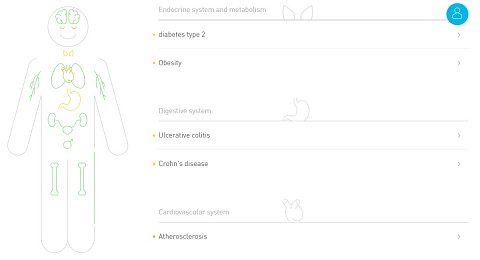
The five health conditions with diagram of the human body.
The organs had been helpfully colour coded, making it easy to see exactly which areas of my body were associated with a high or low risk of the health conditions listed.
I clicked the top result, diabetes type 2, to find out more. This took me to a new page, which included lots more information about the result. A scale showed five colours, two shades of green, yellow, orange and red. I came across helpful explanations of what each colour meant on a separate ‘Disease Risk’ page, though there wasn’t a link to this on the scale itself. I was relieved to find that my result was yellow (right in the middle of the scale), meaning that I was at an average risk.
The rest of result information was split into four sections: ‘Disease prevalence’, ‘Genetic impact’, ‘Lifestyle impact’ and ‘Microbiome protection’. Unfortunately, as I hadn’t taken the DNA test or lifestyle questionnaire (which I later found further down the page), my result was only based on disease prevalence and my microbiome results. The disease prevalence was only based on males, which wasn’t relevant to me, as I’m female.
The rest of the result included a description of the difference between being at risk and actually having the disease. I thought this was really well explained and it helped a lot in understanding my result. It went on to provide a brief overview of its characteristics and listed risk factors associated with diabetes. As well as microbiome composition, these included genetics, weight, lack of exercise and diet.
The final part of the report included information that was too complex for me to fully understand, including a graph with labels such as ‘Potential synthesis’ and ‘High capacity’ that I couldn’t find explanations to. There was a ‘Raw data’ section that listed bacteria, their relative abundance and levels of protection.
Despite the difficulties I had making links between my result and the scientific details at times, the overall result was clear, and I appreciated the fact that so much extra information had been provided.
The rest of the results in this section were formatted in the same way. I found out that I also had an average risk of obesity, ulcerative colitis and Crohn’s disease, but only at moderate (lower than average) risk of developing atherosclerosis, according to my microbiome.
Results Section: Microbiome rating
Going back to the Health page, I was able to view another section called ‘Microbiome rating’, which was shown as four out of 10 and red on the scale.
Clicking through to the full page, I was able to see several other ratings that contributed to the overall Microbiome rating: ‘Disease Protection’, ‘Dietary fibre intake’, ‘Vitamin synthesis’ and ‘Microbiome diversity’. I was rated seven out of 10 for all but Microbiome diversity, which was four out of 10.
Scrolling down the page, I saw that there were further descriptions for each. I was already aware of my Disease protection results, but the others were new to me.
The ‘Dietary fibre and butyrate’ results were preceded by an introductory statement which explained that when fibre is broken down, the microbiome produces butyrate, which protects against disease. I was therefore pleased to see that my microbiome’s potential for fibre metabolism and butyrate synthesis was normal. I was able to click these results to see more information, but similarly to the disease results, a lot of the information was too complex for me to really understand.
I was recommended to eat foods that increase my microbiome’s fibre metabolism. This, at first, seemed vague, but I was again able to click through to another page that provided a list of suggested foods. The references to academic papers that supported these recommendations increased my trust in their beneficial effects and provided the opportunity to further explore the science that they were based on.
My Vitamins results were equally heartening, as all of them (eight in total) showed that my microbiome had an average or above-average ability to produce the range of vitamins included.
Unfortunately though, my Microbiome Diversity rating revealed that my microbiome was less diverse than average. Apparently, this could be due to a recent course of antibiotics, poor diet or an intestinal disorder. I hadn’t recently taken antibiotics, and am careful with what I eat, so hoped that I didn’t have an intestinal disorder that I didn’t know about. I was happy to see that specific food recommendations had been included, as for the fibre result (shown below).
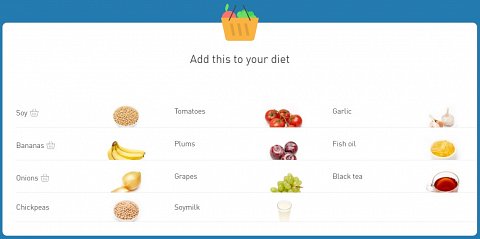
Suggested foods to improve my Microbiome Diversity result.
The detailed description for this result was the best I’d come across, as it simply and clearly explained that more diversity was generally an indicator of better health, whereas a less diverse one caused something called dysbiosis, which was often a precursor of disease.
This was a bit worrying and I wasn’t sure why my microbiome lacked diversity – I eat healthily, including many of the suggested foods in my diet already and exercise regularly, even running my own yoga classes.
Overall, this section provided a lot of detail about various aspects of my microbiome and there was plenty to explore. As with the previous section, I didn’t quite understand all of it but felt that most of the main results were clear and I appreciated the inclusion of food recommendations.
Results Section: Ancestry
The section of the report that I found most fun was Ancestry. The short introduction explained that, by comparing my gut bacteria to those of people around the world, the “citizenship” of my microbiome had been estimated. I was intrigued to read that my microbiome most closely matched those of people living in Danish cities (shown below).
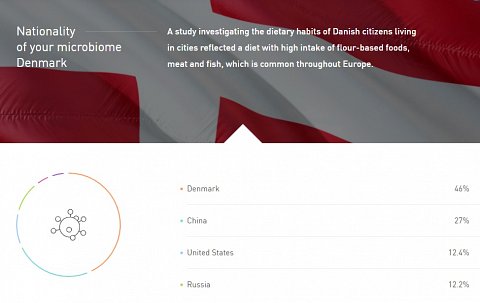
The nationality of my microbiome.
This was further broken down, showing that my microbiome also shared characteristics with people from China, the US, Russia, Malawi and Venezuela. I thought this was a really interesting and unique feature. Although there wasn’t much to take away in terms of advice, it provided a great light-hearted addition to all of the health information.
Results Section: Microbiome type
A similarly light-hearted section was ‘Microbiome type’. This showed which of three types (also known as ‘enterotypes’) of microbiome mine was closest to. It turned out that my microbiome fitted within a type called ‘Urban system’ rather than either of the other two options, ‘Indigene’ and ‘Village Peasant’. A useful diagram showed how these different types overlapped, and where my ‘Current indicator’ was (shown below).
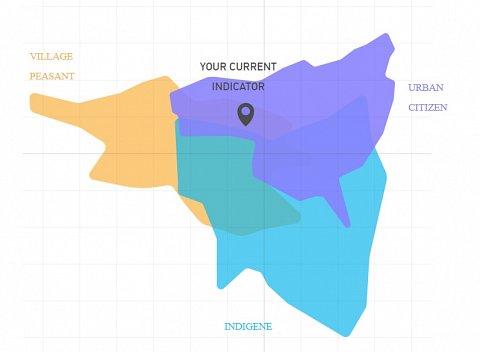
My microbiome type.
Beneath this, the characteristics of each type were explained, with more of the cartoon microbes accompanying quick facts about them. I learnt that my Urban Citizen type was dominated by Bacteroides, meaning it tended to lack diversity and was associated with a Western diet. This seemed to fit well with what I’d already learnt about my microbiome and the extra facts were a bonus.
Summary
The ‘Microbiome Test’ from Atlas Biomed provided loads of information about my gut bacteria. I particularly enjoyed the unusual features, such as finding out the nationality of my microbiome, and thought that the food recommendations provided a helpful way to act on the information.
There was a lot of quite complex extra information provided and the same results were often featured in several different sections of the report, which made it a bit confusing to navigate. However, the wealth of information there was to explore, and its varying complexity, meant that the test could provide insights for a wide range of customers, with differing levels of knowledge and experience of the microbiome. I would, therefore, recommend this test to anyone who is keen on exploring their own gut bacteria in detail.

